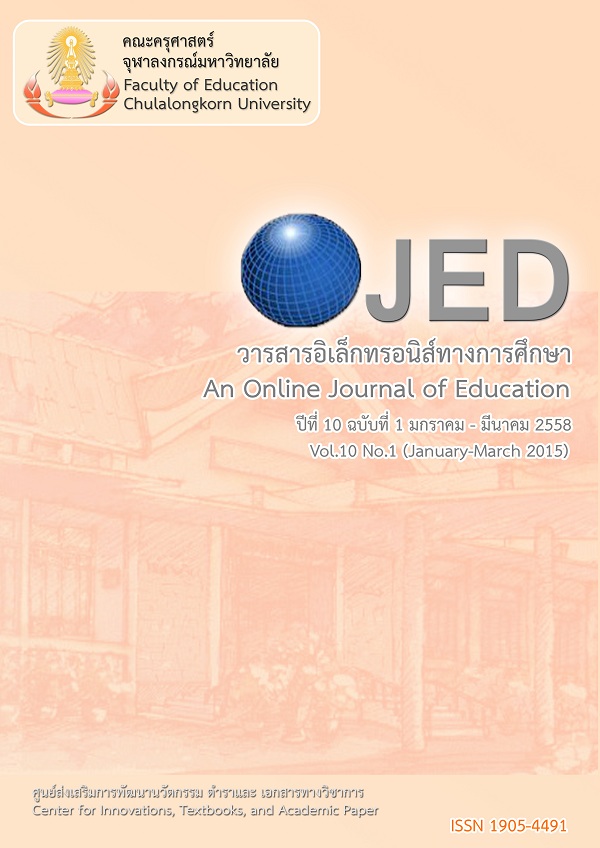การพัฒนาเครื่องมือวัดความฉลาดทางสุขภาวะของนักเรียน
Keywords:
ตัวบ่งชี้ / ความฉลาดทางสุขภาวะ /INDICATOR / HEALTH LITERACYAbstract
การวิจัยครั้งนี้มีวัตถุประสงค์เพื่อ 1) ศึกษาองค์ประกอบและตัวบ่งชี้ของความฉลาดทางสุขภาวะ 2) พัฒนาและตรวจสอบคุณภาพเครื่องมือวัดความฉลาดทางสุขภาวะของนักเรียนระดับชั้นมัธยมศึกษาตอนต้น ผู้วิจัยเก็บข้อมูลโดยการสัมภาษณ์ผู้เชี่ยวชาญ 10 ท่าน เครื่องมือที่ใช้คือ แบบสัมภาษณ์ วิเคราะห์ข้อมูลโดยการวิเคราะห์เนื้อหา จากนั้นนำข้อมูลที่ได้จากการสัมภาษณ์มาสร้างเครื่องมือวัดความฉลาดทางสุขภาวะของนักเรียนระดับชั้นมัธยมศึกษาตอนต้น และนำไปตรวจสอบคุณภาพของแบบวัดด้านความตรงเชิงเนื้อหากับผู้เชี่ยวชาญจำนวน 8 ท่าน ตรวจสอบคุณภาพด้านความเที่ยงแบบสอดคล้องภายใน ตรวจสอบค่าอำนาจจำแนกและความยากง่าย โดยเก็บรวบรวมข้อมูลกับนักเรียนจำนวน 50 คน วิเคราะห์ข้อมูลโดยใช้ดัชนีความสอดคล้อง (IOC) ค่าสัมประสิทธิ์แอลฟาของครอนบาค\
ผลการวิจัยสรุปได้ดังนี้ 1) ความฉลาดทางสุขภาวะประกอบด้วย 5 องค์ประกอบ 12 ตัวบ่งชี้ ได้แก่ องค์ประกอบที่ 1 การเข้าถึง ประกอบด้วย 2 ตัวบ่งชี้ คือ 1) การสืบค้นข้อมูลสุขภาพ และ 2) การเลือกแหล่งข้อมูลสุขภาพ องค์ประกอบที่ 2 ความรู้ความเข้าใจ ประกอบด้วย 2 ตัวบ่งชี้ คือ 1) มีความรู้ข้อมูลสุขภาพพื้นฐาน และ 2) การตีความข้อมูลสุขภาพ องค์ประกอบที่ 3 การประเมิน ประกอบด้วย 3 ตัวบ่งชี้ คือ 1) การตรวจสอบข้อมูลสุขภาพ 2) การวิเคราะห์ข้อมูลสุขภาพ และ 3) การตัดสินใจใช้ข้อมูลสุขภาพ องค์ประกอบที่ 4 การนำความรู้ไปใช้ ประกอบด้วย 3 ตัวบ่งชี้ คือ 1) การวางแผนในการปฏิบัติตนเพื่อให้มีสุขภาพที่ดี 2) การปฏิบัติตนเพื่อส่งเสริมสุขภาพ และ 3) การปรับเปลี่ยนวิธีปฏิบัติตนให้มีสุขภาพที่ดีขึ้น และองค์ประกอบที่ 5 การสื่อสาร ประกอบด้วย 2 ตัวบ่งชี้ คือ 1) การเผยแพร่ข้อมูลสุขภาพ และ 2) การรณรงค์ให้ผู้อื่นเห็นความสำคัญของการปฏิบัติตนเพื่อส่งเสริมสุขภาพ 2) เครื่องมือวัดความฉลาดทางสุขภาวะของนักเรียนมีลักษณะเป็นแบบทดสอบ 15 ข้อ และแบบมาตรประมาณค่า 5 ระดับ จำนวน 48 ข้อ เครื่องมือวัดฉลาดทางสุขภาวะของนักเรียนมีความตรงเชิงเนื้อหาในระดับที่เหมาะสม (ค่า IOC อยู่ระหว่าง 0.50 – 1.000) ข้อคำถามของเครื่องมือวัดความฉลาดทางสุขภาวะของนักเรียนในแต่ละองค์ประกอบมีความสอดคล้องและสามารถวัดได้ในคุณลักษณะเดียวกัน Cronbrach อยู่ระหว่าง 0.779 – 0.902 มีค่าอำนาจจำแนกและความยากง่ายในระดับที่เหมาะสม
This research aims 1) to study the components and indicators of health literacy, 2) to develop and validate a tool of health literacy for secondary school students. The data were collected by interviewing 10 experts have used the interview data were analyzed using content analysis. The data obtained from the interviews to develop a tool of health literacy for secondary school students. And to determine the quality of the content validity of this tool by 8 experts. The internal consistency reliabilities (Cronbach's a coefficients), discrimination indices and difficulty were investigated by 50 students.
The result showed that 1) the components of health literacy for secondary school consisted of five components twelve indicators; the first access indicator are 1) inquiry and 2) the selection of health information. Component 2 cognitive indicators are: 1) basic health knowledge and 2) the interpretation of health information. Component 3 assessment indicators are: 1) checking health information 2) health information analysis and 3) the decision to use health information. Component 4 apply of health information indicators are: 1) planning for good health 2) practices for good health and 3) change for good health. And Component 4 communication indicators are: 1) the dissemination of health information and 2) to campaign others for good health, 2) Tool for health literacy of the students was develop test 15, and rating scales the 5 levels with 48 items measuring health literacy of the students are content validity, the appropriate level (IOC is between 0.50 to 1.00), appropriate internal consistency reliabilities (Cronbach's a coefficients range from 0.779 to 0.902) and the discrimination and difficulty appropriate level.




